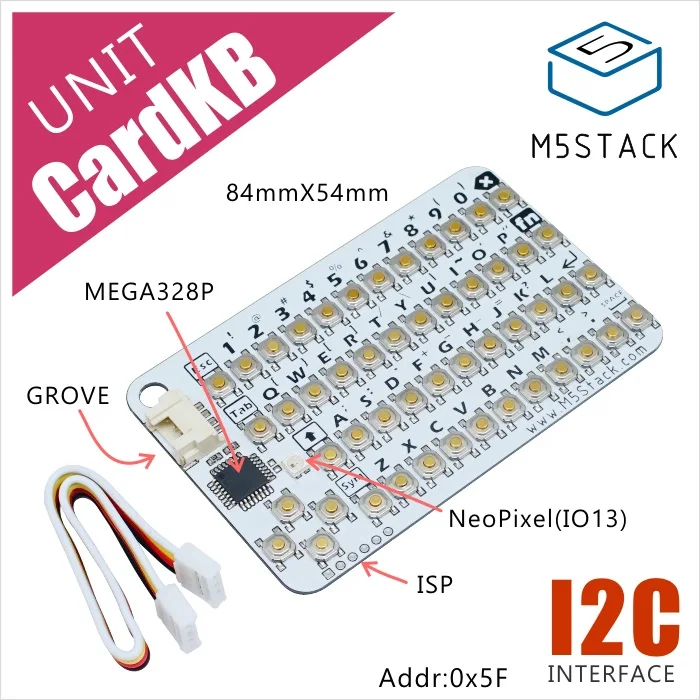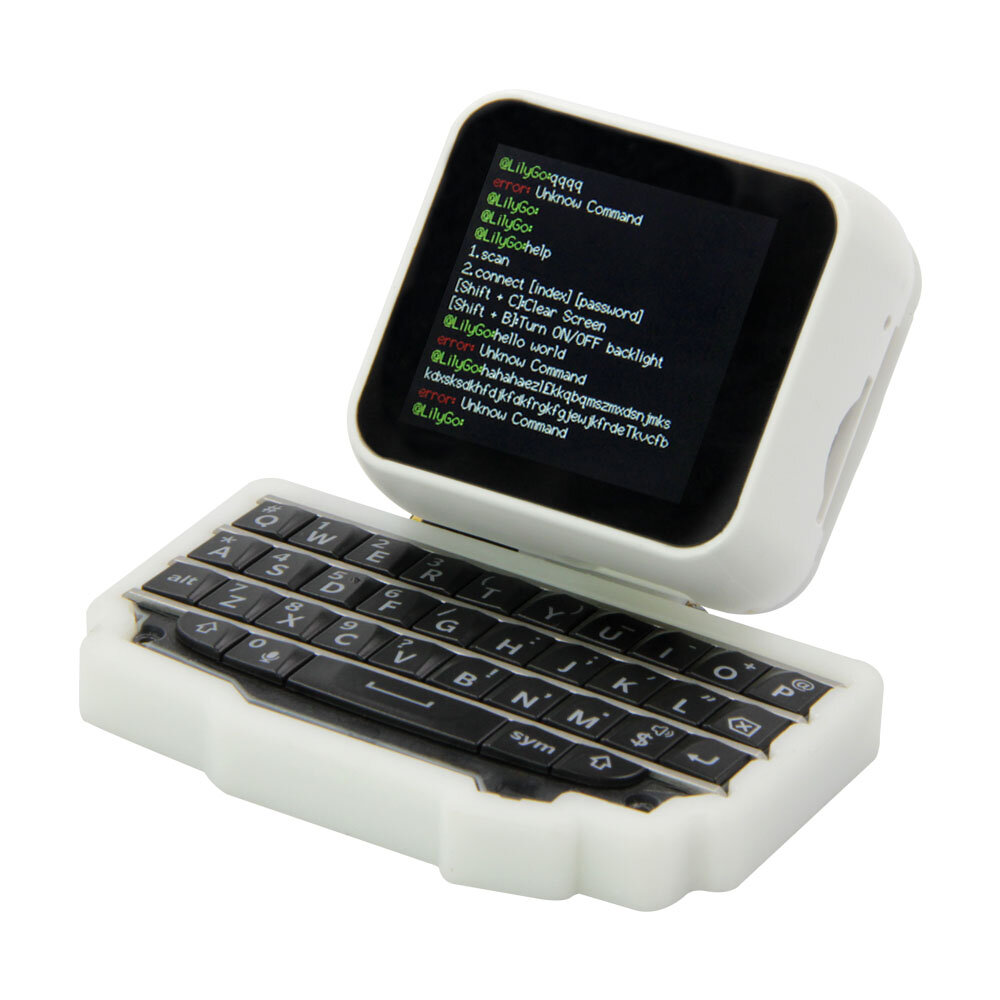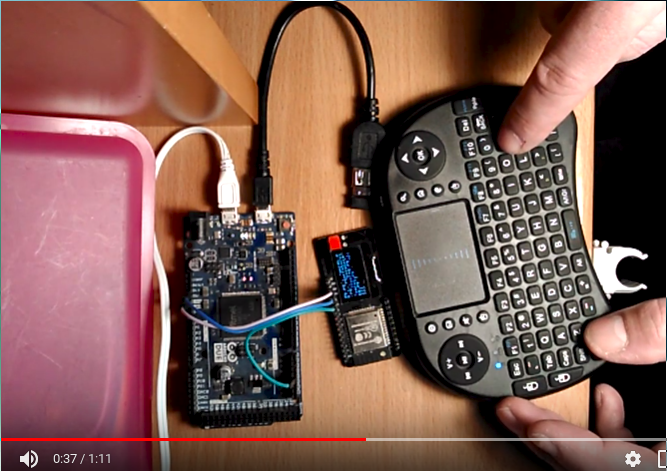- ESP32 implementation for HID over GATT Keyboard and Mouse (Bluetooth Low Energy). Including serial API for external modules (compatible to Adafruit EZKey HID).
- VGA, SSD1306 Controller, PS/2 Mouse and Keyboard Controller, Graphics Library, Graphical User Interface (GUI), Sound Engine, Game Engine and ANSI/VT Terminal for the ESP32 FastAccelStepper A high speed stepper library for Atmega 328p (nano) and ESP32.
ESP32-Ethernet-Kit: ESP32-Ethernet-Kit is an ESP32-based development board produced by Espressif. It consists of two development boards, the Ethernet board A and the PoE board B, The Ethernet board contains Bluetooth / Wi-Fi dual-mode ESP32-WROVER-E module and IP101GRI, a Single Port 10/100 Fast Ethernet Transceiver (PHY). While the ESP32 boasts an extensive feature list (Wikipedia), the biggest feature that draws the eye is the built-in bluetooth v4.2 with BLE support. But that statement can be a misleading, while the hardware is there, the software support for using Bluetooth is missing.
- 1Features
- 1.3'Chip' on the module
- 2Video DAC LTSpice Simulation
- 3Headers (Rev 1 board)
- 3.2H2 - 5V SRC Select Jumper (Rev 1 Board)
- 4Connectors (Rev 1 board)
- 4.3J2 - FTDI #1 - Rev 1
- 4.4J6 - FTDI #2 - Rev 1
- 5Headers (Rev 2 board)
- 6Connectors (Rev 2 board)
- 6.6J2 - FTDI #1 - Rev 2
- 6.7J3 - FTDI #2 - Rev 2
- 8FabGL GPIOs assignment summary - fabgl dev board rev2
- 9Software
- 9.2FabGL
Features[edit]
- ESP32 Module
- 6-bit VGA color
- 2:2:2 R:G:B
- 2 x PS-2 DIN connectors
- 5V mouse/keyboard
- 3.3V to 5V level shifters
- Better than 5V keyboard with series resistors
- 10K pull-ups on both sides
- 2 x FTDI connectors
- 5V DC Jack
- 3.3V regulator (optional)
- GVS pins for extra ESP32 pins
- 95x95mm form factor
- 6-32 mounting holes
ESP-32 Module[edit]
- Uses the ESP32 DevKit ESP32-WROOM GPIO Pinout
- On board Blue LED = Arduino Pin 2
- There are various modules out there with different pinouts, but this card uses this one
ESP-32 Module Pinout[edit]
'Chip' on the module[edit]
ESP32 Pin Usage - Rev 1[edit]
ESP32 Pin Usage - Rev 2[edit]
Module Features[edit]
- Architecture: Xtensa Dual-Core 32-bit LX6
- CPU frequency: up to 240MHz
- Total RAM available: 528KB (part of it reserved for system)
- BootROM: 448KB
- Internal FlashROM: none
- External FlashROM: code and data, via SPI Flash; usual size 4MB
- GPIO: 34 (GPIOs are multiplexed with other functions, including external FlashROM, UART, etc.)
- UART: 3 RX/TX UART (no hardware handshaking), one TX-only UART
- SPI: 4 SPI interfaces (one used for FlashROM)
- I2C: 2 I2C (bitbang implementation available on any pins)
- I2S: 2
- ADC: 12-bit SAR ADC up to 18 channels
- DAC: 2 8-bit DACs
- RMT: 8 channels allowing accurate pulse transmit/receive
- Programming: using BootROM bootloader from UART - due to external FlashROM and always-available BootROM bootloader, the ESP32 is not brickable
Video DAC LTSpice Simulation[edit]
- Video is 2:2:2 - R:G:B
Summing Resistor DAC[edit]
- 5% resistors are 'good enough'
- 1V into 75 Ohm VGA load
- 3.3V drive
- ESP32 has 40 mA drive
- Uses 10 mA (max)
- R4 = 1.2 mA to -10 mA
- R3 = 1.1 mA to -5.3 mA
- Output in 4 steps
- 0V
- 0.3V
- 0.65V
- 0.96V
Esp32 Keyboard
Headers (Rev 1 board)[edit]
H1 - 3.3V SRC select[edit]
- 1-2 = Get 3.3V from ESP32 on-board regulator
- 2-3 = Get 3.3V from on-board regulator (Default)
H2 - 5V SRC Select Jumper (Rev 1 Board)[edit]
- 5V power options for the 5V to 3.3V regulator
- 2x4 header
- Care must be taken to install the correct jumpers
- USB jumper sends out 5V when a USB cable is connected to the ESP32 module
Power from DC Jack[edit]
- Do not connect USB cable when the DC jack is used
- 1-2 = VUSB - Install - Power to ESP32
- 3-4 = DCIN - Install - Power comes from DC jack
- 5-6 = FTDI5V_1 - Do not install
- 7-8 = FTDI5V_2 - Do not install
Power from USB on ESP32 module[edit]
- 1-2 = VUSB - Install - 5V comes from USB on ESP32 module
- 3-4 = DCIN - Do not install
- 5-6 = FTDI5V_1 - Do not install
- 7-8 = FTDI5V_2 - Do not install
Power from FTDI #1 (Rev 1)[edit]
- Do not use this position with 'most' FTDI cards since they will drive 5V on the Rx/Tx pins when the FTDI jumper is set to 5V
Power from FTDI #2[edit]
- Do not use this position with 'most' FTDI cards since they will drive 5V on the Rx/Tx pins when the FTDI jumper is set to 5V
Connectors (Rev 1 board)[edit]
P2/P4 = GVS - Rev 1[edit]
- Ground/Voltage/Signal lines
- GPIO13
- GPIO14
- GPIO16
- GPIO17
- GPIO35
- GPIO34
- VN
- VP
P3 - VGA - Rev 1[edit]
- ESP32 pins
- This table is incorrect - it has the Lower/Higher bits swapped
J2 - FTDI #1 - Rev 1[edit]
- GND
- RTS (Not used)
- 5V (Power in if H2 is configured)
- RX (from card to External FTDI)
- TX (from External FTDI to card)
- CTS (Not used)
Connect to FTDI card - Rev 1[edit]
- Set FTDI jumper to 3.3V (unlike picture below)
- Cross-over pins 4 and 5 when connecting to FTDI card (Rev 1 only)
J6 - FTDI #2 - Rev 1[edit]
- Rev 1 board won't program or boot with FDTI #2 card attached
- This interface is in common with the USB-to-Serial interface on the ESP32 module
- GND
- RTS (Not used)
- 5V (Power in if H2 is configured)
- TX2 (from card to External FTDI)
- RX2 (from External FTDI to card)
- CTS (Not used)
- Requires a cross-over of the Transmit and Receive pins if directly connecting to an FTDI part
- Earlier versions of the FabGL schematics used pin 12 for RX
- Most recent (2020-02) ANSI terminal uses pin 34
- Board won't boot with an FTDI interface attached and USB cable attached
- This is an issue for the ANSI Terminal sketch
- Original pins were (Rev 1 matches original)
Here's why using pin 12 is a bad idea:
UART2 Rework[edit]
- The easiest way to do this is to wire the FTDI to GPIO34 pin instead of pin J6-5
- Not pretty, but it does work fine
- This is what is needed to permanently rework the board
- Rework is only needed to run 'stock' FabGL code that uses the UART2 port on the ESP32 (like the ansi terminal)
- Cut trace/adding jumper to rev 1 board
- Route to GPIO34
- Cut as follows (cut in white)
- Add wire as follows (add wire in white)
- [2020-01-20] Tested rework on card and it worked
Connect to FTDI card - Rev 1[edit]
- Set FTDI jumper to 3.3V
- Cross-over pins 4 and 5 when connecting to FTDI card (Rev 1 only)
J3 - PS/2 Keyboard - Rev 1[edit]
- Purple DIN 6 connector
- ESP32 pins
J4 - PS/2 Mouse - Rev 1[edit]
- DIN 6 connector
- ESP32 pins
J5 - Audio Out - RCA Jack - Rev 1[edit]
- ESP32 pins
J15 - 5mm Terminal Block - Rev 1[edit]
- 5V
- Gnd
Headers (Rev 2 board)[edit]
- The Rev 2 board changes around headers and connectors
H1 - 5V - Rev 2[edit]
- The ESP32-VGA can be powered from either the DC Jack or ESP32 USB power
- Warning: Do not power from 5V Power jack and connect USB cable to the ESP32 module at the same time
- The ESP32 module has blocking diode to protect the module
- If the 5V DC jack has a power supply attached with lower voltage it could result in the supplied being shorted between the USB 5V and the DC power jack
- This is not an issue if the DC power jack is disconnected
- The ESP32 module has blocking diode to protect the module
- This could be used for an external power switch
H2/H3 - GVS - Rev 2[edit]

- 3x4 header
- Ground/Voltage/Signal lines
- GPIO35
- GPIO12
- VN/I39
- VP/I36
Connectors (Rev 2 board)[edit]
P1 - PS/2 Mouse - Rev 2[edit]
- DIN 6 connector
- ESP32 pins
P2 - PS/2 Keyboard - Rev 2[edit]
- Purple DIN 6 connector
- ESP32 pins
P3 - VGA - Rev 2[edit]


- ESP32 pins
- This table is incorrect - it has the video bits reversed
P4 - Audio Out - RCA Jack - Rev 2[edit]
- ESP32 pins

J1 - 5V Power - Rev 2[edit]
- Center +5V
J2 - FTDI #1 - Rev 2[edit]
- This interface is in common with the USB-to-Serial interface on the ESP32 module
- Pinout
- GND
- RTS (Not used)
- 5V (Not used)
- RX (from card to External FTDI)
- TX (from External FTDI to card)
- CTS (Not used)
Connect to FTDI card - Rev 2[edit]
- Set FTDI jumper to 3.3V
J3 - FTDI #2 - Rev 2[edit]
- Most recent (2020-02) ANSI terminal uses pin 34 for Rx
- Pinout
- GND
- RTS (Not used)
- 5V (Power in if H2 is configured)
- RX (from External FTDI to ESP32 card)
- TX (from ESP32 card to External FTDI)
- CTS (Not used)
Connect to FTDI card - Rev 2[edit]
- Set FTDI jumper to 3.3V (image below shows jumper set to 5V which is wrong)
J4 - SD Card - Rev 2[edit]
- Brought to GVS header pins (Rev 1)
- Brought to SD Card (Rev 2)
VGA - Resistor Selection[edit]
- ESP32 has a 3.3V driver which can drive more than 10 mA
- Ideal case drive current
- 0.7V (full scale VGA level) into 75 Ohms = 9.33 mA
- 2/3 of the current or 6.16 mA comes from the lower value resistor (digital most significant bit)
- 1/3 of the current or 3.08 mA comes from the higher value resistor (digital least significant bit)
- R-2R values
- Ideal resistor values are 417.9 ohms and 835.7 ohms
- 1% standard values are 422 (Mouser), 845 (Mouser) Ohms
- Get closest values
- 0V, 0.228V, 0.460V, 0.693V
- Voltage steps are:
- Current steps are:
FabGL GPIOs assignment summary - fabgl dev board rev2[edit]
I2C (not usable with VGA)[edit]
SPI Display - VSPI (not usable with VGA)[edit]
Software[edit]
Arduino Programming[edit]
- Board : 'DOIT ESP32 DEVKIT V1'
FabGL[edit]
- Display Controller features/applications
- VGA
- SSD1306
- PS/2 Mouse and Keyboard Controller
- Graphics Library
- Sound Engine
- Game Engine
- ANSI/VT Terminal for the ESP32
FabGL Libraries[edit]
- FabGL - ESP32 Display Controller and Graphics Library
FabGL Arduino library[edit]
Installing the released library
Using Latest FabGL builds[edit]
Here's how I did it Policewala gunda hindi movie.
- Install drivers via Arduino from the Library Manager. These are not the latest files. Space Invaders should run but not have sound (as of now because it's the older version).
- Move the FabGL from the Arduino libraries file folder to the desktop.
- Copy the FabGL from the GitHub download to the Arduino files folder (where you removed the other folder).
- Examples will now be the latest.
- Compile/download/test the new files. You know it works if you now get sound from Space Invaders.
- Save as where you would normally save your Arduino sketches.
MicroPython[edit]
- MicroPython Homepage
- GitHub repo (MicroPython)
- Examples (MicroPython)
- Libraries (MicroPython)
Esp32 Keyboard Usb
ESP-IDF[edit]
Operating Systems[edit]
- 3x4 header
- Ground/Voltage/Signal lines
- GPIO35
- GPIO12
- VN/I39
- VP/I36
Connectors (Rev 2 board)[edit]
P1 - PS/2 Mouse - Rev 2[edit]
- DIN 6 connector
- ESP32 pins
P2 - PS/2 Keyboard - Rev 2[edit]
- Purple DIN 6 connector
- ESP32 pins
P3 - VGA - Rev 2[edit]
- ESP32 pins
- This table is incorrect - it has the video bits reversed
P4 - Audio Out - RCA Jack - Rev 2[edit]
- ESP32 pins
J1 - 5V Power - Rev 2[edit]
- Center +5V
J2 - FTDI #1 - Rev 2[edit]
- This interface is in common with the USB-to-Serial interface on the ESP32 module
- Pinout
- GND
- RTS (Not used)
- 5V (Not used)
- RX (from card to External FTDI)
- TX (from External FTDI to card)
- CTS (Not used)
Connect to FTDI card - Rev 2[edit]
- Set FTDI jumper to 3.3V
J3 - FTDI #2 - Rev 2[edit]
- Most recent (2020-02) ANSI terminal uses pin 34 for Rx
- Pinout
- GND
- RTS (Not used)
- 5V (Power in if H2 is configured)
- RX (from External FTDI to ESP32 card)
- TX (from ESP32 card to External FTDI)
- CTS (Not used)
Connect to FTDI card - Rev 2[edit]
- Set FTDI jumper to 3.3V (image below shows jumper set to 5V which is wrong)
J4 - SD Card - Rev 2[edit]
- Brought to GVS header pins (Rev 1)
- Brought to SD Card (Rev 2)
VGA - Resistor Selection[edit]
- ESP32 has a 3.3V driver which can drive more than 10 mA
- Ideal case drive current
- 0.7V (full scale VGA level) into 75 Ohms = 9.33 mA
- 2/3 of the current or 6.16 mA comes from the lower value resistor (digital most significant bit)
- 1/3 of the current or 3.08 mA comes from the higher value resistor (digital least significant bit)
- R-2R values
- Ideal resistor values are 417.9 ohms and 835.7 ohms
- 1% standard values are 422 (Mouser), 845 (Mouser) Ohms
- Get closest values
- 0V, 0.228V, 0.460V, 0.693V
- Voltage steps are:
- Current steps are:
FabGL GPIOs assignment summary - fabgl dev board rev2[edit]
I2C (not usable with VGA)[edit]
SPI Display - VSPI (not usable with VGA)[edit]
Software[edit]
Arduino Programming[edit]
- Board : 'DOIT ESP32 DEVKIT V1'
FabGL[edit]
- Display Controller features/applications
- VGA
- SSD1306
- PS/2 Mouse and Keyboard Controller
- Graphics Library
- Sound Engine
- Game Engine
- ANSI/VT Terminal for the ESP32
FabGL Libraries[edit]
- FabGL - ESP32 Display Controller and Graphics Library
FabGL Arduino library[edit]
Installing the released library
Using Latest FabGL builds[edit]
Here's how I did it Policewala gunda hindi movie.
- Install drivers via Arduino from the Library Manager. These are not the latest files. Space Invaders should run but not have sound (as of now because it's the older version).
- Move the FabGL from the Arduino libraries file folder to the desktop.
- Copy the FabGL from the GitHub download to the Arduino files folder (where you removed the other folder).
- Examples will now be the latest.
- Compile/download/test the new files. You know it works if you now get sound from Space Invaders.
- Save as where you would normally save your Arduino sketches.
MicroPython[edit]
- MicroPython Homepage
- GitHub repo (MicroPython)
- Examples (MicroPython)
- Libraries (MicroPython)
Esp32 Keyboard Usb
ESP-IDF[edit]
Operating Systems[edit]
- ESP32 DEVKITV1 module schematics (also helpful discussion)
Schematic[edit]
Rev 2 Changes[edit]
- Rev 1 board won't program or boot with FDTI #2 card attached
- Earlier FabGL had GPIO12 instead of GPIO34
- Move FTDI Rx line (GPIO12 to GPIO34)
- Swap FTDI pins 4 and 5 (FTDI connectors)
- Allow direct connect to FTDI card (no swap)
- Add SD Card connector
- MISO => GPIO 16
- MOSI => GPIO 17
- CLK => GPIO 14
- CS => GPIO 13
- Remove I/O pins from GVS connector
- Replace H1/H2 with 1x2 to select/remove DC jack power
- Remove Polysilicone fuse
- Change ESP32 board name silkscreen
- Add SD card connector
Ble Keyboard
Prototype[edit]
- PS2X49
- Purple = Keyboard
- Green = Mouse
- 6-32/4-40 Standoffs, screws, nuts
- Cabling
